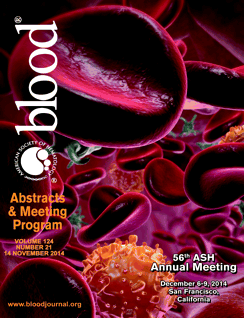Abstract
Introduction MDR1 gene expression has recently been reported to be associated with clinical outcome in imatinib-resistant patients with chronic myeloid leukemia (CML) on second-line nilotinib treatment (Agrawal et al., Leukemia 2014). High MDR1 expression was predictive for achieving deeper cytogenetic and molecular responses as well as duration of chronic phase. We thus prospectively evaluated the value of MDR1 expression analysis in the first-line situation within a large European, multicenter trial of CML patients under treatment with nilotinib.
Methods 305 patients enrolled on the ENEST1st study (Evaluating Nilotinib Efficacy and Safety in clinical Trials as First-Line Treatment, NCT01061177) consented to participate in this substudy. Of these, 225 patients were evaluable due to sample availability and presence of typical e14a2 and/or e13a2 BCR-ABL1 transcripts. The median age was 52 (range 18-83), 39% were female. Prior to therapy, the expression of MDR1, BCR-ABL1, and GUSB were determined using a serial dilution of a plasmid constructs harboring MDR1 and GUSB and BCR-ABL1 and GUSB sequences. Ratios MDR1/GUSB and BCR-ABL1/GUSB were calculated. ROC curves were established using initial MDR1 and BCR-ABL1 expression levels aiming to achieve the primary endpoint of MR4 (defined as BCR-ABL1 ≤ 0.01% on the International Scale [BCR-ABL1IS] or undetectable BCR-ABL1 in cDNA with ≥ 10,000 ABL1 transcripts) at 18 months or to achieve a MMR (≤ 0.1% BCR-ABL1IS) at 9 months. Mann-Whitney tests have been applied using a significance level of 0.05.
Results At 9 months, 161 patients (72%) achieved MMR and at 18 months 111 patients (49%) a MR4. The median ratio MDR1/GUSB among all evaluable patients was 11.4% (range, 0.6-318.1), the median ratio BCR-ABL1/GUSB was 22.2% (range 0.09-198.7). Initial BCR-ABL1/GUSB levels did not predict MMR or MR4 at 9 or 18 months. However, initial ratios MDR1/GUSB were predictive for the achievement of MMR at 9 months (best cut-off 3.8%, sensitivity 88.8%, specificity 26.6%, AUC 0.598, p=0.022) and for reaching MR4 at 18 months (best cut-off 7.90%, sensitivity 72.1%, specificity 51.8%, AUC 0.624, p=0.001).
Conclusions High MDR1 expression levels in newly diagnosed CML patients appear to be associated with deeper molecular responses within the first 18 months of nilotinib treatment. These data merit further exploration and if validated would justify the investigation of frontline CML therapy guided by baseline MDR1 expression levels.
Dietz:Novartis: Research Funding. Hanfstein:Bristol-Myers Squibb: Honoraria; Novartis: Research Funding. Rousselot:Novartis: Research Funding. Lange:Novartis: Consultancy, Honoraria, Research Funding. Maier:Novartis: Research Funding. Foroni:Novartis: Research Funding. Gerrard:Novartis: Research Funding. Talmaci:Novartis: Research Funding. Janssen:Novartis: Research Funding. Frank:Novartis: Employment. Saussele:Pfizer: Honoraria, Travel, Travel Other; Bristol-Myers Squibb: Honoraria, Research Funding, Travel, Travel Other; Novartis: Honoraria, Research Funding, Travel Other. Giles:Novartis: Honoraria, Research Funding. Hochhaus:Novartis: Research Funding. Müller:Novartis: Honoraria, Research Funding.
Author notes
Asterisk with author names denotes non-ASH members.

